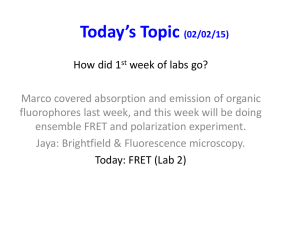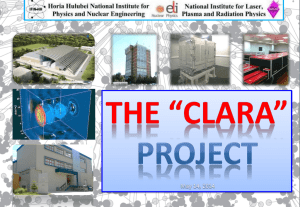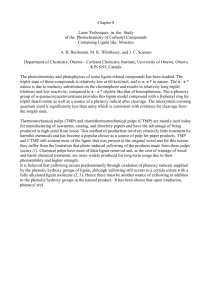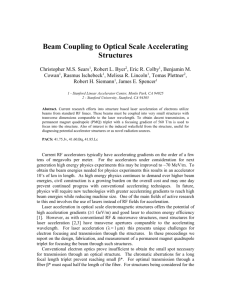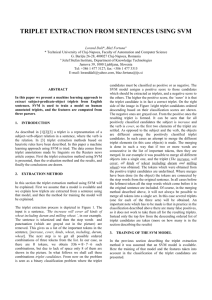Document
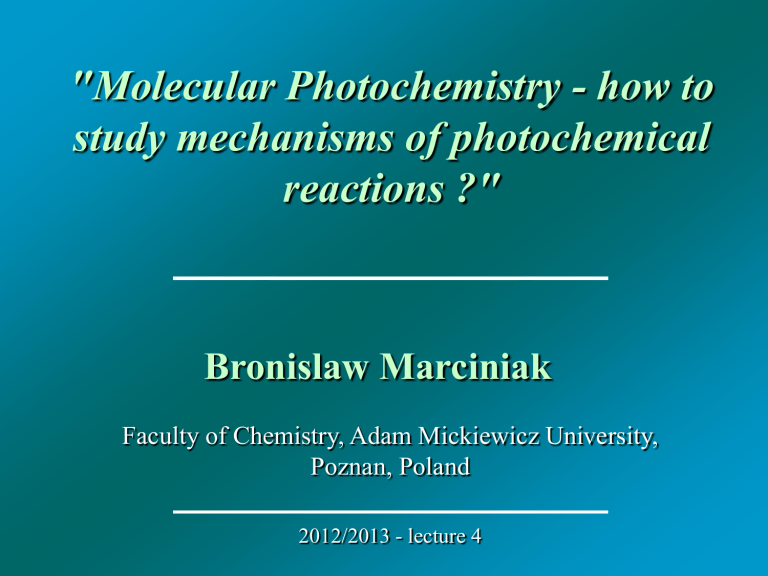
"Molecular Photochemistry - how to study mechanisms of photochemical reactions ?"
Bronislaw Marciniak
Faculty of Chemistry, Adam Mickiewicz University,
Poznan, Poland
2012/2013 - lecture 4
Contents
1. Introduction and basic principles
(physical and chemical properties of molecules in the excited states, Jablonski diagram, time scale of physical and chemical events, definition of terms used in photochemistry).
2. Qualitative investigation of photoreaction mechanisms steady-state and time resolved methods
(analysis of stable products and short-lived reactive intermediates, identification of the excited states responsible for photochemical reactions).
3. Quantitative methods
(quantum yields, rate constants, lifetimes, kinetic of quenching, experimental problems, e.g. inner filter effects).
Contents cont.
4. Laser flash photolysis in the study of photochemical reaction mechanisms (10
–3 – 10 –12 s).
5. Examples illustrating the investigation of photoreaction mechanisms:
sensitized photooxidation of sulfur (II)-containing organic compounds,
photoinduced electron transfer and energy transfer processes,
sensitized photoreduction of 1,3-diketonates of Cu(II),
photochemistry of 1,3,5,-trithianes in solution.
3. Laser flash photolysis in the study of photochemical reaction mechanisms (10
–3 – 10 –12 s).
ns laser flash photolysis
Laser start
Z
M
P
R
C
K
0.04
1 s
0.04
0.02
0.00
0.0
0.02
2.0x10
-7 time [s]
4.0x10
-7
6.0x10
-7
12 s
45 s
0.00
110 s
150 s
400 600 wavelength [nm]
800
Fig . Transient absorption spectra of intermediates following the quenching of benzophenone triplet by Ph-S-CH
2
-COO-N + (C
4
H
9
)
4
Inset: kinetic trace at 710 nm.
(0.01M).
0.06
0.04
0.02
0.04
0.02
0.00
710 nm
520 nm
0.04
0.02
0.00
0
0 200 400 600 800
Time [ns]
50
710 nm
100 150
Time [ s] after 1 s after 150
s
0.00
400 500 600
Wavelength [nm]
700 800
Fig.
Transient absorption spectra following triplet quenching of BP (2 mM) by
C
6
H
5
-S-CH
2
-COO N + R
4
(10 mM) after 1
s and 150
s delays after the flash in
MeCN solution. Insets: kinetic traces on the nanosecond and microsecond time scales
C O
R
R
R
N
R
O O
C
CH
S
2
R
R
R
N
R
O O
C
C O
CH
2
S
BP PTAAS
(Hofmann elimination)
C OH
R
N
R
R
R
R
C O
R
N
R
R
CH
2
S
CO
2
C O
+ H
+
C OH
R
N
R
R
R
HS + HG
HS + HG
Nanosecond flash photolysis
•
Spectra Physics INDI, 266, 355, 532 nm,
10 Hz, 6-8 ns, 450 mJ @ 1064 nm
•
Si photodiode, 2 ns rise-time
• flow cell + temperature controlled holder
• fibre coupled 150 W Xe lamp (Applied
Photophysics) with pulser, 500
s plateu
(or alternatively 175 W Xe Cermax CW lamp)
•
Acton Spectra Pro SP-2155 monochromator with dual grating turret
•
Hamamatsu R955 PMT + SRS PS-310 power supply
•
LeCroy WR 6100A DSO
•
PC (GPIB, NI-DAQ, LabView)
• opto-mechanics Standa
HS + HG
Instrumentation
OD
log
I ref
( t )
I signal
( t )
Femtosecond transient absorption spectrometer
Pump-Probe Femtosecond
Laser at Notre Dame
University
NDRL femto lab
Femtosecond transient absorption spectrometer:
• time resolution < 100 fs
• sensitivity better than OD=0.005
• excitation: tunable Ti:Sapphire laser
(750-840 nm at fundamental)
• detection: time-gated CCD camera
•
SHG (375-420 nm)
• THG (250-280 nm)
AMU Center for Ultrafast Laser Spectroscopy
AMU Physics Department
Picosecond Transient Absorption
Interfejs IBM PC
Fotopowielacz Monochromator
L iniowy mikropozycjoner
532 nm lub 355 nm lub 266 nm
Inter fejs
Światło "białe"
Opóźnienie stałe
Opóźnienie zmienne
D20
Wiązka analizująca
G enerator harmon icznych
Pikose kundowy
Lase r YAG: Nd ze wzm ac niaczem
Wią zka wzbudzają ca
Rys. 6 Schemat pikosekundowego układu do badania absorbcji przejściowej
Sub-nanosecond emission spectrometer IBH System 5000
• excitation: nanoLEDs (295, 370, 408, 474 nm)
• FWHM 200 ps
• detection: PMT operated in TCSPC mode
• PC based MCA: 6 ps/channel (50 ns time window / 8196 channels)
• emission and fluorescence anisotropy measurements
Picosecond emission spectrometer (TCSPC):
• excitation: tunable Ti:Sapphire laser
(720-1000 nm) pumped by Argon-Ion laser
• detection: PMT (IRF 200 ps) or MCP
(IRF 25 ps) operated in TCSPC mode
• SHG (360-500 nm)
• THG (240-330 nm)
•
FWHM 1.5 ps
AMU Center for
Ultrafast Laser
Spectroscopy
Long Lifetime Sample
Triplet-Triplet Absorption Spectra of
Organic Molecules in Condensed Phases
Ian Carmichael and Gordon L. Hug
Journal of Physical and Chemical Reference Data 15, 1-150 (1986) http://www.rcdc.nd.edu/compilations/Tta/tta.pdf
Methods of Determining
Triplet Absorption Coefficients
•
Energy Transfer Method
•
Singlet Depletion Method
•
Total Depletion Method
•
Relative Actinometry
Energy Transfer (General)
•
Two compounds placed in a cell.
•
Compound R has a known triplet absorption coefficient.
•
Compound T has a triplet absorption coefficient to be determined.
•
Ideally, the triplet with the higher energy can be populated.
•
Thus triplet energy of one can be transferred to the other.
Energy Transfer (General)
•
If the lifetimes of both triplets are long in the absence of the other molecule, then
•
One donor triplet should yield one acceptor triplet.
•
In an ideal experiment e
T
* = e
R
* (
OD
T
/
OD
R
)
Note it doesn’t matter whether T or R is the triplet energy donor.
3 R* + 1 T
1 R + 3 T*
[ 3 R*] = [ 3 R*]
0 exp( k obs
t)
[ 3 T*] = [ 3 T*]
{1 exp( k obs
t)} k obs
= k et
[ 1 T]
0
[ 3 T*]
= [ 3 R*]
0
1.0
0.8
0.6
[c] (
M)
0.4
0.2
[
3
R*]
[
3
T*]
0.0
-0.5 0.0
0.5
1.0
1.5
2.0
2.5
3.0
3.5
4.0
4.5
Time (
s)
Initial Conditions
[ 3 R*]
0
= 1 M
[ 1 T]
0
= 1 mM k et
= 1 × 10 9 M -1 s -1
Kinetic Corrections
(1) Need to account for unimolecular decay of the triplet donor:
3 D* 1 D k
D
3 D* + 1 A 1 D + 3 A* k et
The probability of transfer (P tr
) is no longer one, but
P tr
= k et
[ 1 A] / (k et
[ 1 A] + k
D
) e
A
* = e
D
* ( OD
A
/ OD
D
) / P tr
3 D* + 1 A
1 D + 3 A*
[ 3 D*] = [ 3 D*]
0 exp( k obs
t)
[ 3 A*] = [ 3 A*]
{1 exp( k obs
t)} k obs
= k
D
+ k et
[ 1 A]
0
[ 3 A*]
= [ 3 R*]
0
P tr
1.0
0.8
0.6
[c] (
M)
0.4
0.2
[
3
R*]
[
3
T*]
[
3
D*]
[
3
A*]
0.0
-0.5 0.0
0.5
1.0
1.5
2.0
2.5
3.0
3.5
4.0
4.5
Time (
s)
Unimolecular 3 D* decay k
D
= 0.5 × 10 6 s -1
Otherwise same initial conditions as before k et
= 1 × 10 9 M -1 s -1
[ 1 A]
0
= 1 mM
Kinetic Corrections
(2) May need to account for the unimolecular decay
3 A* 1 A k
A if the rise time of 3 A* is masked by its decay. Then the growth-and decay scheme can be solved as
[ 3 A*] =W {exp(-k
A
t) - exp(-k et
[ 1 A]t-k
D
t)}
W =[ 3 D*]
0 k et
[ 1 A] / (k
D
+ k et
[ 1 A] - k
A
) the maximum of this concentration profile is at t max t max
= ln{k
A
/(k et
[ 1 A] + k
D
)} / (k
A
- k et
[ 1 A] - k
D
)
OD
A
= OD
A
(t max
) exp(k
A t max
)
Kinetics involving decay of both triplets
1.0
0.8
0.6
[c] ( M)
0.4
[
3
A*] infinite
A
[
3
D*]
[
3
A*]
0.2
0.0
-0.5 0.0
0.5
1.0
1.5
2.0
2.5
3.0
3.5
4.0
4.5
Time ( s)
Unimolecular 3 D* decay k
D
3 D* 1 D
= 0.5 × 10 6 s -1
Unimolecular 3 A* decay k
A
3 A* 1 A
= 0.5 × 10 6 s -1
Energy Transfer
3 D* + 1 A 1 D + 3 A* k et
= 1 × 10 9 M -1 s -1
[ 1 A]
0
= 1 mM
Uncertainty in Probability of Transfer
If there is a dark reaction for bimolecular deactivation of
3 D* + 1 A 1 D + 1 A, k
DA then the true probability of transfer is
P tr
= k et
[ 1 A] / (k
DA
[ 1 A] + k et
[ 1 A] + k
D
)
Energy Transfer
Advantages and Disadvantages
•
The big advantage is over the next method which depends on whether the triplet-triplet absorption overlaps the ground state absorption.
•
The big disadvantage is the uncertainty in the probability of transfer.


